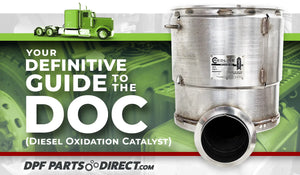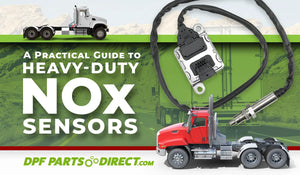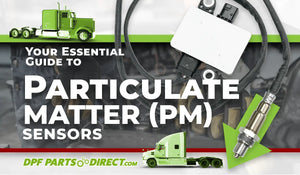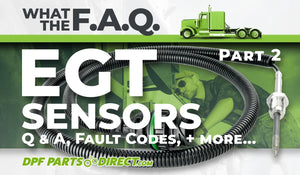When you think about your truck's aftertreatment system, the Diesel Particulate Filter (DPF) probably comes to mind first. But there's another crucial component working tirelessly upstream: the Diesel Oxidation Catalyst, or DOC. Think of the DOC as the first line of defense, breaking down harmful exhaust emissions before they cause bigger problems down the line.
This guide will walk you through everything you need to know about what your DOC is, how it works, and how to maintain it to keep your truck running strong. 💪
Q: What is a Diesel Oxidation Catalyst (DOC)?
A: A Diesel Oxidation Catalyst (DOC) is a critical part of your truck's emissions system, often called a diesel catalytic converter. It's designed with a honeycomb-like internal structure coated in precious metals that create a chemical reaction to neutralize pollutants. This honeycomb design maximizes the surface area, allowing the hot exhaust to react more effectively with the catalyst.
The best part? A DOC works passively, meaning it doesn't require active regeneration or special cycles to do its job. In the United States, the effectiveness of these devices is regulated by the Environmental Protection Agency (EPA) and the California Air Resources Board (CARB).
Q: Where is the DOC Located?
A: You'll almost always find the DOC located just before the Diesel Particulate Filter (DPF) in the exhaust flow. Its exact position can vary depending on the manufacturer and year of the engine.
- 2007–2009 Engines: The aftertreatment system typically consists of a DOC and a DPF.
- 2010+ Engines: These newer systems include a DOC, DPF, and a Selective Catalytic Reduction (SCR) system. You can easily identify these trucks by the presence of a Diesel Exhaust Fluid (DEF) tank.
Q: What Does a DOC Actually Do?
A: The primary job of the DOC is to convert harmful chemicals in diesel exhaust into less harmful substances like carbon dioxide and water. Untreated diesel exhaust is full of nasty stuff like carbon monoxide, unburned hydrocarbons, and organic particulates. The DOC uses oxygen to "oxidize" and break down these pollutants in a single, passive step.
This process is highly effective, reducing hydrocarbons by 40-75% and carbon monoxide by 10-60%. On newer trucks (2010+), the DOC also plays a vital role in converting nitric oxide (NO) into nitrogen dioxide (NO2), which is essential for the downstream SCR system to properly reduce NOx emissions.
Q: What Causes a DOC to Fail?
A: While a DOC can naturally wear out over about a decade as the precious metals degrade, most failures happen prematurely. Here are the most common culprits:
Contamination: Oil, fuel, or coolant leaking into the exhaust system can quickly contaminate and ruin the catalyst. White, blue, or black smoke from the exhaust is a major warning sign. Ethylene glycol from coolant is especially damaging and will poison the catalyst almost instantly.
Excessive Idling: This is one of the toughest conditions for an aftertreatment system. Low exhaust temperatures during idling can lead to a buildup of soot and carbon on the inlet of the DOC, a condition known as face plugging.
Exhaust Leaks: The entire emissions system relies on maintaining heat and pressure. Any leak allows them to escape, hurting the efficiency of the DOC and other components.
Lack of Maintenance: Just like any filter, the aftertreatment system needs regular service. Trucks with harsh duty cycles—like school buses, garbage trucks, and inner-city delivery vehicles—require more frequent maintenance.
Q: Can a DOC Be Cleaned?
A: Yes, it absolutely can and should be cleaned! A DOC is a flow-through device, so any soot and ash that ends up in your DPF has already passed through the DOC.
Whenever your DPF is removed for cleaning, the DOC should be removed, inspected, and cleaned at the same time using the same methods. This is the best way to prevent face plugging and ensure the entire system functions properly.
Q: What is DOC Face Plugging?
A: Face plugging is a severe buildup of carbon and soot on the inlet face (the "front") of the DOC. This blockage restricts exhaust flow, creating back pressure that chokes the engine and cripples the performance of the DPF and SCR system downstream.
This problem is most common in trucks that do a lot of idling, haul light loads, or operate at low speeds. Under these conditions, the exhaust doesn't get hot enough for passive regeneration to keep the system clean.
The best fix is to take the DOC and DPF to a professional aftertreatment cleaning facility.
Q: When Should a DOC Be Replaced?
A: Because they have no moving parts, DOCs can easily last ten years or more with proper maintenance. You'll eventually need to replace it when the precious metals inside have deteriorated from old age.
If your DOC fails sooner, it's critical to identify and fix the underlying cause—like an oil leak, coolant leak, or plugged EGR valve—before installing a new one. Otherwise, you'll just ruin the replacement part.
Q: How Much Does a New DOC Cost?
A: The cost of a replacement DOC depends on your truck's engine, but you can typically expect to pay between $1,500 and $3,000 for a heavy-duty unit.
The high price comes from the precious metals like platinum used in the catalyst. While it may seem expensive, investing in proper maintenance and a high-quality replacement is the smartest way to save money in the long run. Be wary of unusually cheap replacements, as a low-quality part can compromise your entire aftertreatment system.
Q: How Can I Tell if a DOC Replacement is High-Quality?
A: Look for a replacement part that is described as an "OEM replacement" or "exact fit". These terms mean the part was engineered specifically for your truck's make and model. A high-quality replacement will also come with a warranty, and it should be sold by a company with a strong reputation and an expert support hotline to help you get the right part.
A word of caution on "reman" units: A remanufactured DOC is essentially a used part from another truck that has been cleaned and put back up for sale. The problem is that you have no way of knowing its history. It could be from a much older truck with far more miles than yours. You might save a little money upfront, only to have it fail a few weeks later.
Q: Where Should I Buy a Replacement DOC?
A: You have several options, including a dealership or a local aftermarket parts store. However, dealers can be very expensive, and local stores may not have a wide selection or the technical expertise you need if you run into an issue.
For a better balance of value and expertise, look for a specialized online supplier.
DPFPartsDirect.com is a great place to buy your replacement DOC and any other diesel emissions system-related parts.
It is easy to buy from us online.
We have a huge inventory in stock and ready to be shipped.
We sell high-quality OEM and aftermarket replacement parts.
Orders typically ship the same day.
We have diesel technicians available to provide you with assistance if you need it.
Buy all your diesel emissions systems replacement parts from DPFPartsDirect.com today.
Key Terms to Know:
-
DOC – Diesel Oxidation Catalyst
-
DPF – Diesel Particulate Filter
-
SCR – Selective Catalytic Reduction
-
DEF – Diesel Exhaust Fluid
-
OEM – Original Equipment Manufacturer










Comments 0